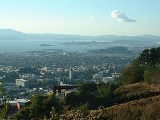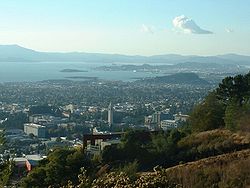
Molecular Foundry
Encyclopedia

The Molecular Foundry
The Molecular Foundry is a nanoscience user facility located at the Lawrence Berkeley National LaboratoryLawrence Berkeley National Laboratory
The Lawrence Berkeley National Laboratory , is a U.S. Department of Energy national laboratory conducting unclassified scientific research. It is located on the grounds of the University of California, Berkeley, in the Berkeley Hills above the central campus...
in Berkeley, California
Berkeley, California
Berkeley is a city on the east shore of the San Francisco Bay in Northern California, United States. Its neighbors to the south are the cities of Oakland and Emeryville. To the north is the city of Albany and the unincorporated community of Kensington...
, and is one of five nanoscale science research centers sponsored by the United States Department of Energy
United States Department of Energy
The United States Department of Energy is a Cabinet-level department of the United States government concerned with the United States' policies regarding energy and safety in handling nuclear material...
. The Molecular Foundry provides support to nanoscience researchers in university, industrial and government laboratories around the world.
The Foundry is led by director Carolyn R. Bertozzi
Carolyn R. Bertozzi
Carolyn Ruth Bertozzi is an American chemist. She is the T.Z. and Irmgard Chu Distinguished Professor of Chemistry and Professor of Molecular and Cell Biology at the University of California, Berkeley; Professor of Molecular and Cellular Pharmacology at the University of California, San...
and deputy directors Jim DeYoreo, Jeff Bokor and Mark Alper.
The Foundry allows free access to instruments, techniques and collaborators for nanoscience research that is in the public domain and intended for open publication. Proposals for user projects are solicited to promote interdisciplinary collaboration among scientists studying nanoscale phenomena in materials science
Materials science
Materials science is an interdisciplinary field applying the properties of matter to various areas of science and engineering. This scientific field investigates the relationship between the structure of materials at atomic or molecular scales and their macroscopic properties. It incorporates...
, physics
Physics
Physics is a natural science that involves the study of matter and its motion through spacetime, along with related concepts such as energy and force. More broadly, it is the general analysis of nature, conducted in order to understand how the universe behaves.Physics is one of the oldest academic...
, electrical engineering
Electrical engineering
Electrical engineering is a field of engineering that generally deals with the study and application of electricity, electronics and electromagnetism. The field first became an identifiable occupation in the late nineteenth century after commercialization of the electric telegraph and electrical...
, environmental engineering
Environmental engineering
Environmental engineering is the application of science and engineering principles to improve the natural environment , to provide healthy water, air, and land for human habitation and for other organisms, and to remediate polluted sites...
, biology
Biology
Biology is a natural science concerned with the study of life and living organisms, including their structure, function, growth, origin, evolution, distribution, and taxonomy. Biology is a vast subject containing many subdivisions, topics, and disciplines...
and chemistry
Chemistry
Chemistry is the science of matter, especially its chemical reactions, but also its composition, structure and properties. Chemistry is concerned with atoms and their interactions with other atoms, and particularly with the properties of chemical bonds....
in six interdependent facilities:
Imaging and Manipulation of Nanostructures
Led by Facility Director Frank Ogletree and Scientific Director Miquel Salmeron- State-of-the-art characterization and manipulation of nanostructures—from “hard” to very “soft” matter—combining electron microscopy, optical microscopy and scanning probe microscopyScanning probe microscopyScanning Probe Microscopy is a branch of microscopy that forms images of surfaces using a physical probe that scans the specimen. An image of the surface is obtained by mechanically moving the probe in a raster scan of the specimen, line by line, and recording the probe-surface interaction as a...
.
Nanofabrication
Led by Facility Director Stefano Cabrini and Scientific Director Jeff Bokor- Advanced lithographyLithographyLithography is a method for printing using a stone or a metal plate with a completely smooth surface...
and thin-film processing emphasizing integration with chemical and biological nanosystems and the development of nanoscale electronicElectronicsElectronics is the branch of science, engineering and technology that deals with electrical circuits involving active electrical components such as vacuum tubes, transistors, diodes and integrated circuits, and associated passive interconnection technologies...
, magnetic and photonic devices.
Inorganic Nanostructures
Led by Facility Director Delia Milliron and Scientific Director A. Paul Alivisatos- The science of semiconductorSemiconductorA semiconductor is a material with electrical conductivity due to electron flow intermediate in magnitude between that of a conductor and an insulator. This means a conductivity roughly in the range of 103 to 10−8 siemens per centimeter...
, carbon and hybrid nanostructures—including design and synthesis of nanocrystals, nanowires and nanotubesCarbon nanotubeCarbon nanotubes are allotropes of carbon with a cylindrical nanostructure. Nanotubes have been constructed with length-to-diameter ratio of up to 132,000,000:1, significantly larger than for any other material...
—and study of their electronic applications.
Organic and Macromolecular Synthesis
Led by Facility Director Frantisek Svec and Scientific Director Jean FréchetJean Frechet
Professor Jean M.J. Fréchet is the Henry Rapoport Chair of Organic Chemistry at the Department of Chemistry, University of California, Berkeley...
- Studies of “soft" materials—including synthesis of organic molecules, macromolecules, polymers and their assemblies, with access to functional systems, photoactive, organic-inorganic hybrid and porous materials.
Biological Nanostructures
Led by Facility Director Ron Zuckermann and Scientific Director Carolyn R. BertozziCarolyn R. Bertozzi
Carolyn Ruth Bertozzi is an American chemist. She is the T.Z. and Irmgard Chu Distinguished Professor of Chemistry and Professor of Molecular and Cell Biology at the University of California, Berkeley; Professor of Molecular and Cellular Pharmacology at the University of California, San...
- New materials based on the self-assemblySelf-assemblySelf-assembly is a term used to describe processes in which a disordered system of pre-existing components forms an organized structure or pattern as a consequence of specific, local interactions among the components themselves, without external direction...
of biopolymers and bio-inspired polymers, new probes for bio-imaging and synthetic biologySynthetic biologySynthetic biology is a new area of biological research that combines science and engineering. It encompasses a variety of different approaches, methodologies, and disciplines with a variety of definitions...
techniques to re-engineer organisms and create hybrid biomolecules to interface with devices.
Theory of Nanostructured Materials
Led by Facility Director Jeff Neaton and Scientific Director Steven LouieSteven Gwon Sheng Louie
Steven Gwon Sheng Louie is a computational condensed-matter physicist. He is a professor of physics at the University of California, Berkeley and senior faculty scientist in the Materials Sciences Division at Lawrence Berkeley National Laboratory, where his research focuses on nanoscience...
- Theoretical support to guide understanding of new principles, behavior and experiments—including electrical transport in nanoscale molecular junctions, self-assembly of biological nanostructures and computation of spectroscopySpectroscopySpectroscopy is the study of the interaction between matter and radiated energy. Historically, spectroscopy originated through the study of visible light dispersed according to its wavelength, e.g., by a prism. Later the concept was expanded greatly to comprise any interaction with radiative...
at hybrid nanoscale interfaces.
The Foundry was dedicated on March 24, 2006 and received Leadership in Energy and Environmental Design
Leadership in Energy and Environmental Design
Leadership in Energy and Environmental Design consists of a suite of rating systems for the design, construction and operation of high performance green buildings, homes and neighborhoods....
Gold recognition from the US Green Building Council in 2007 for its optimization of energy usage.
External links
- http://foundry.lbl.gov/
- http://www.lbl.gov/Science-Articles/Archive/MSD-Foundry-rating.html

